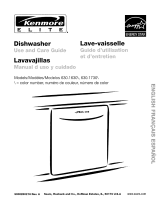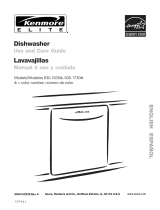
11
WARNING
You could be seriously scalded if you allow hot water to splash
out of the dishwasher. OPEN THE DOOR CAREFULLY during any
wash or rinse cycle. Do not fully open the door until water noises
have stopped.
To Start Unit:
• Door must be open. Press the “ON/OFF” button to turn the unit on.
• One of the Wash Cycle Indicator Lights will be ashing to show
you are in the Wash Cycle selection mode.
• Press the “<” or “>” button to select the desired wash cycle.
• Press the “START” button (Wash Cycle Indicator Light will stop
ashing)
• Close the door to start the cycle
Note: Rinse Agent Indicator Light will be illuminated if the unit
needs Rinse Agent.
Note: If you close the door without pressing the start button the
unit will beep.
To Cancel the Cycle:
• Open the door just far enough to expose the controls. Be careful
of water Splash Out!
• Press and hold the “START/RESET” button until the “Active” Indica-
tor Light goes out.
• Close the door and wait for about 1 minute for the dishwasher
to drain.
• Open the door and press the “ON/OFF” button.
• You are now ready to start a new cycle.
Setting Options (Rinse Agent Amount / Extra Dry Heat
Activation / Cycle Completion Signal Tone Level)
• Door must be open. Press the “ON/OFF” button to turn the unit
on.
• One of the Wash Cycle Indicator Lights will be ashing to show
you are in the Wash Cycle selection mode.
• To enter the Options Setup Mode, press and hold down the “>”
button, then press and release the “START RESET” button, then
release the “>” button.
• The “Clean” Indicator Light and at least one addition Indicator Light
will be ashing to show you are in the Options Setup Mode.
• Press the “>” button to select the option you would like to ad-
just.
o If the “CLEAN” and “RINSE AGENT” Indicator Lights are ashing
you are ready to set the amount of Rinse Agent the unit will
dispense.
o If the “CLEAN” and “SANITIZED” Indicator Lights are ashing you
are ready to turn your Extra Dry Heat option on/off.
o If the “CLEAN” and “SANITIZED” and “RINSE AGENT” Indicator
Lights are ashing you are ready to set the Cycle Completion
Signal Tone Level.
To Set the Amount of Rinse Agent Dispensed
NOTE: If your glasses have spots you need more Rinse Agent. If your
glasses have streaks you need less Rinse Agent.
• With the “CLEAN” and “RINSE AGENT” Indicator Lights ashing.
• Press the “<” button to change the amount of Rinse Agent Dis-
pensed.
• As you press the “<” button you will notice the Wash Cycle Indica-
tor Lights illuminating.
■ If none of the Wash Cycle Indicator Lights are illuminated,
the Rinse Agent Dispenser is turned off.
■ If one of the Wash Cycle Indicator Lights are illuminated, the
Rinse Agent Dispenser is set to deliver the lowest charge of Rinse
Agent.
■ If two of the Wash Cycle Indicator Lights are illuminated, the
Rinse Agent Dispenser is set to deliver a medium charge of Rinse
Agent.
■ If three of the Wash Cycle Indicator Lights are illuminated, the Rinse
Agent Dispenser is set to deliver the largest charge of Rinse Agent.
• Press “START” to save your settings.
To Turn the Extra Dry Heat On or Off
• With the “CLEAN” and “SANTITIZED” Indicator Lights ashing.
• Press the “<” button to change the Extra Dry Heat setting.
• As you press the “<” button you will notice the Wash Cycle Indica-
tor Lights illuminating.
o If none of the Wash Cycle Indicator Lights are illuminated, the
Extra Dry Heat option is turned off.
o If one of the Wash Cycle Indicator Lights are illuminated, the
Extra Dry Heat is turned on.
• Press “START” to save your settings.
To Set the Cycle Completion Signal Tone Level
• With the “CLEAN” and “SANITIZED” and “RINSE AGENT” Indicator
Lights ashing.
• Press the “<” button to change the Cycle Completion Signal Tone
Level.
• As you press the “<” button you will notice the Wash Cycle Indi-
cator Lights illuminating and the Cycle Completion Signal Tone
level changing.
o If none of the Wash Cycle Indicator Lights are illuminated, there
will be no tone. The Cycle Completion Signal is turned off.
o If one of the Wash Cycle Indicator Lights are illuminated, there
will be a low Cycle Completion Signal Tone Level.
o If two of the Wash Cycle Indicator Lights are illuminated, there
will be a medium Cycle Completion Signal Tone Level.
o If three of the Wash Cycle Indicator Lights are illuminated, you
will be at the maximum Cycle Completion Signal Tone Level.
• Press “START” to save your settings.
OPERATING THE SHX3AM, SHX5AL, & SHX6AP





















